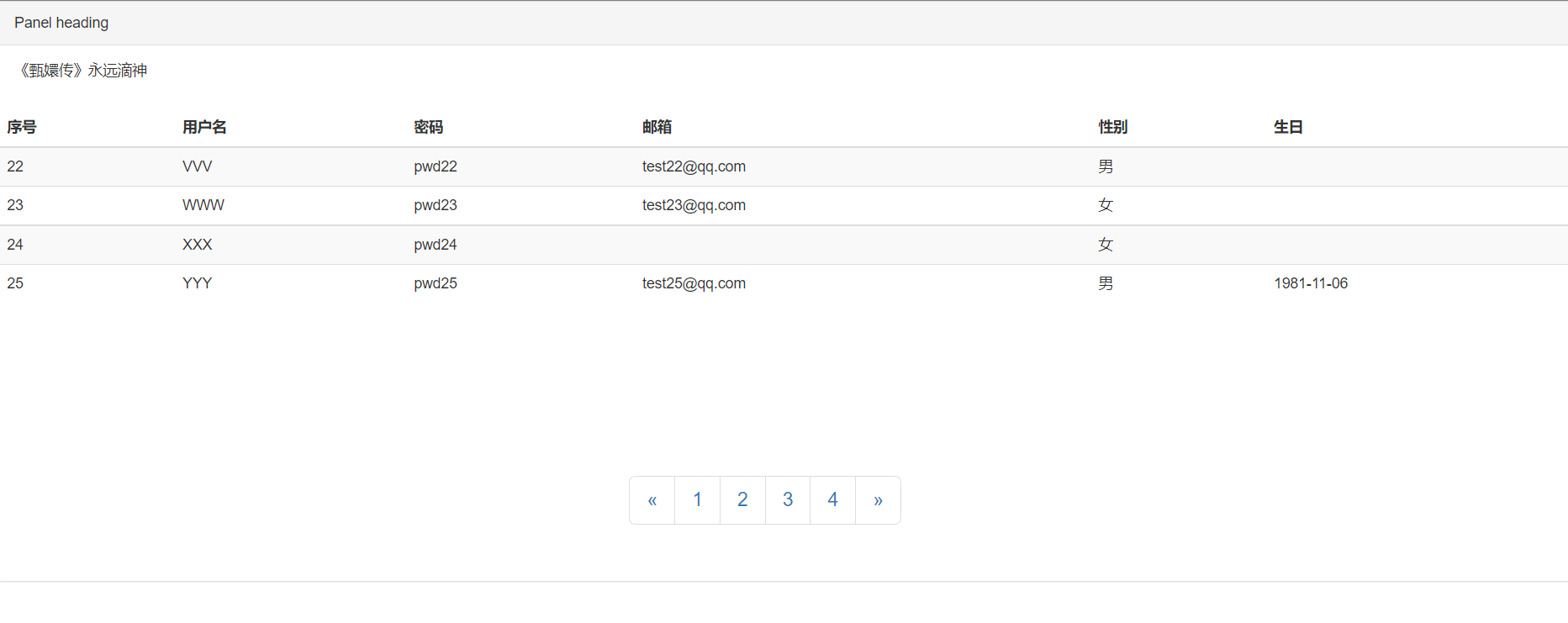Springboot integrates JdbcTemplate to realize paging query
1, Foreword
When doing the SpringBoot back-end project, I want to adopt the back-end paging mode. The back-end paging is to process the data at the back-end first and then send it to the front-end. The front-end only needs to access the corresponding page and get the data of the corresponding page. In the writing of back-end paging, both MyBatis and JPA have ready-made back-end paging components, while JdbcTemplate does not. Therefore, take the entity class User as an example to record your learning process.
2, Development tools and environment
-
Computer operating system: Win10
-
Java version: jdk1.0 eight
-
MySQL database version: mysql-8.0.26-winxx64
-
Editor: IntelliJ IDEA 2021.2 Enterprise Edition
-
SpringBoot version: 2.6.3
-
working directory

3, SpringBoot basic configuration
1. Spring initializr settings
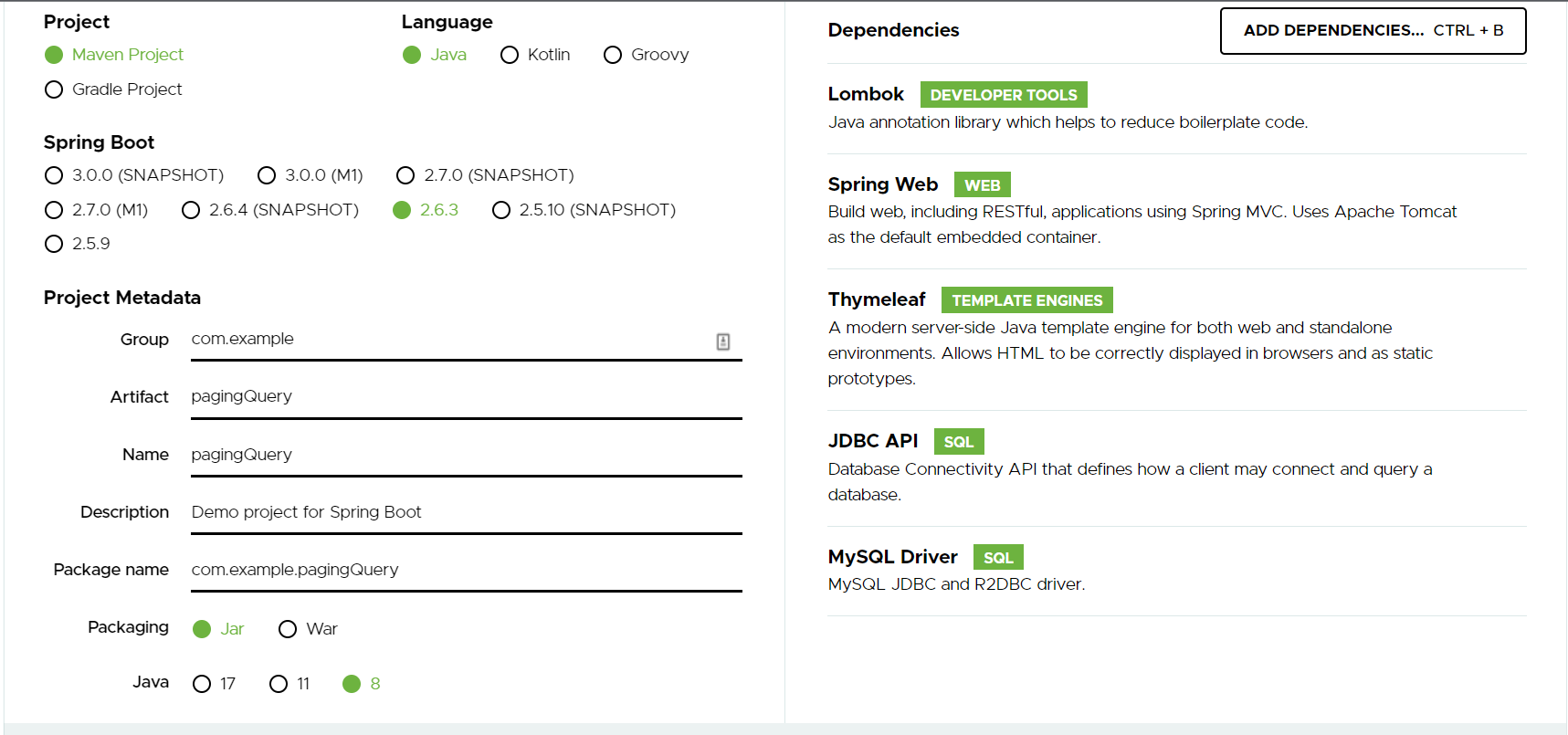
2,pom.xml
<?xml version="1.0" encoding="UTF-8"?> <project xmlns="http://maven.apache.org/POM/4.0.0" xmlns:xsi="http://www.w3.org/2001/XMLSchema-instance" xsi:schemaLocation="http://maven.apache.org/POM/4.0.0 https://maven.apache.org/xsd/maven-4.0.0.xsd"> <modelVersion>4.0.0</modelVersion> <parent> <groupId>org.springframework.boot</groupId> <artifactId>spring-boot-starter-parent</artifactId> <version>2.6.3</version> <relativePath/> <!-- lookup parent from repository --> </parent> <groupId>com.example</groupId> <artifactId>pagingQuery</artifactId> <version>0.0.1-SNAPSHOT</version> <name>pagingQuery</name> <description>Demo project for Spring Boot</description> <properties> <java.version>1.8</java.version> </properties> <dependencies> <dependency> <groupId>org.springframework.boot</groupId> <artifactId>spring-boot-starter-jdbc</artifactId> </dependency> <dependency> <groupId>org.springframework.boot</groupId> <artifactId>spring-boot-starter-thymeleaf</artifactId> </dependency> <dependency> <groupId>org.springframework.boot</groupId> <artifactId>spring-boot-starter-web</artifactId> </dependency> <dependency> <groupId>mysql</groupId> <artifactId>mysql-connector-java</artifactId> <scope>runtime</scope> </dependency> <dependency> <groupId>org.projectlombok</groupId> <artifactId>lombok</artifactId> <optional>true</optional> </dependency> <dependency> <groupId>org.springframework.boot</groupId> <artifactId>spring-boot-starter-test</artifactId> <scope>test</scope> </dependency> </dependencies> <build> <plugins> <plugin> <groupId>org.springframework.boot</groupId> <artifactId>spring-boot-maven-plugin</artifactId> <configuration> <excludes> <exclude> <groupId>org.projectlombok</groupId> <artifactId>lombok</artifactId> </exclude> </excludes> </configuration> </plugin> </plugins> </build> </project>
3,application.properties
spring.datasource.username=root spring.datasource.password=123456 spring.datasource.url=jdbc:mysql://localhost:3306/jdbcTemplate?serverTimezone=UTC&useUnicode=true&characterEncoding=utf-8 spring.datasource.driver-class-name=com.mysql.cj.jdbc.Driver
- The database name I use here is JDBC template
- MySQL 8. The version of XX needs to set the time zone serverTimezone
4, Preparation - Database
1. Create database and User table
# Create database
CREATE DATABASE `jdbcTemplate`CHARACTER SET utf8 COLLATE utf8_general_ci;
# Create user table
CREATE TABLE `jdbctemplate`.`user`( `id` INT(4) UNSIGNED NOT NULL, `username` VARCHAR(30) NOT NULL, `password` VARCHAR(30) NOT NULL, `email` VARCHAR(30), `gender` INT(1), `birth` DATE, PRIMARY KEY (`id`) ) ENGINE=INNODB CHARSET=utf8 COLLATE=utf8_general_ci;
#Insert data into user table
INSERT INTO `jdbctemplate`.`user` (`id`, `username`, `password`, `email`, `gender`, `birth`) VALUES ('1', 'AAA', 'pwd01', 'test01@qq.com', '1', '1999-03-26');
INSERT INTO `jdbctemplate`.`user` (`id`, `username`, `password`, `email`, `gender`, `birth`) VALUES ('2', 'BBB', 'pwd02', 'test02@qq.com', '2', '2001-11-15');
INSERT INTO `jdbctemplate`.`user` (`id`, `username`, `password`, `email`, `gender`, `birth`) VALUES ('3', 'CCC', 'pwd03', 'test03@qq.com', '3', '2004-07-07');
INSERT INTO `jdbctemplate`.`user` (`id`, `username`, `password`, `email`, `gender`) VALUES ('4', 'DDD', 'pwd04', 'test04@qq.com', '0');
UPDATE `jdbctemplate`.`user` SET `gender` = '0' WHERE `id` = '2';
UPDATE `jdbctemplate`.`user` SET `gender` = '1' WHERE `id` = '3';
UPDATE `jdbctemplate`.`user` SET `birth` = '1994-07-16' WHERE `id` = '4';
INSERT INTO `jdbctemplate`.`user` (`id`, `username`, `password`, `email`, `gender`, `birth`) VALUES ('5', 'EEE', 'pwd05', 'test05@qq.com', '0', '2002-06-14');
INSERT INTO `jdbctemplate`.`user` (`id`, `username`, `password`, `email`, `gender`, `birth`) VALUES ('6', 'FFF', 'pwd06', 'test06@qq.com', '1', '2003-05-08');
INSERT INTO `jdbctemplate`.`user` (`id`, `username`, `password`, `email`, `gender`, `birth`) VALUES ('7', 'GGG', 'pwd07', 'test07@qq.com', '1', '1991-12-27');
INSERT INTO `jdbctemplate`.`user` (`id`, `username`, `password`, `email`, `gender`, `birth`) VALUES ('8', 'HHH', 'pwd08', 'test08@qq.com', '0', '2006-02-16');
INSERT INTO `jdbctemplate`.`user` (`id`, `username`, `password`, `email`, `gender`, `birth`) VALUES ('9', 'III', 'pwd09', 'test09@qq.com', '1', '1998-04-09');
INSERT INTO `jdbctemplate`.`user` (`id`, `username`, `password`, `email`, `gender`, `birth`) VALUES ('10', 'JJJ', 'pwd10', 'test10@qq.com', '0', '1997-07-24');
INSERT INTO `jdbctemplate`.`user` (`id`, `username`, `password`, `email`, `gender`, `birth`) VALUES ('11', 'KKK', 'pwd11', 'test11@qq.com', '0', '1995-01-28');
INSERT INTO `jdbctemplate`.`user` (`id`, `username`, `password`, `email`, `gender`, `birth`) VALUES ('12', 'LLL', 'pwd12', 'test12@qq.com', '1', '1995-01-28');
INSERT INTO `jdbctemplate`.`user` (`id`, `username`, `password`, `email`, `gender`, `birth`) VALUES ('13', 'MMM', 'pwd13', 'test13@qq.com', '0', '1995-07-21');
INSERT INTO `jdbctemplate`.`user` (`id`, `username`, `password`, `email`, `gender`, `birth`) VALUES ('14', 'NNN', 'pwd14', 'test14@qq.com', '1', '1994-03-25');
INSERT INTO `jdbctemplate`.`user` (`id`, `username`, `password`, `gender`, `birth`) VALUES ('15', 'OOO', 'pwd15', '0', '1991-12-30');
INSERT INTO `jdbctemplate`.`user` (`id`, `username`, `password`, `email`) VALUES ('16', 'PPP', 'pwd16', 'test16@qq.com');
INSERT INTO `jdbctemplate`.`user` (`id`, `username`, `password`, `email`, `gender`) VALUES ('17', 'QQQ', 'pwd17', 'test17@qq.com', '1');
INSERT INTO `jdbctemplate`.`user` (`id`, `username`, `password`, `email`, `gender`, `birth`) VALUES ('18', 'RRR', 'pwd18', 'test18@qq.com', '0', '2000-02-25');
INSERT INTO `jdbctemplate`.`user` (`id`, `username`, `password`, `email`, `birth`) VALUES ('19', 'SSS', 'pwd19', 'test19@qq.com', '1999-12-31');
INSERT INTO `jdbctemplate`.`user` (`id`, `username`, `password`, `email`, `gender`, `birth`) VALUES ('20', 'TTT', 'pwd20', 'test20@qq.com', '1', '2000-07-14');
INSERT INTO `jdbctemplate`.`user` (`id`, `username`, `password`, `email`, `gender`, `birth`) VALUES ('21', 'UUU', 'pwd21', 'test21@qq.com', '0', '1995-07-14');
INSERT INTO `jdbctemplate`.`user` (`id`, `username`, `password`, `email`, `gender`) VALUES ('22', 'VVV', 'pwd22', 'test22@qq.com', '1');
INSERT INTO `jdbctemplate`.`user` (`id`, `username`, `password`, `email`) VALUES ('23', 'WWW', 'pwd23', 'test23@qq.com');
INSERT INTO `jdbctemplate`.`user` (`id`, `username`, `password`, `gender`) VALUES ('24', 'XXX', 'pwd24', '0');
INSERT INTO `jdbctemplate`.`user` (`id`, `username`, `password`, `email`, `gender`, `birth`) VALUES ('25', 'YYY', 'pwd25', 'test25@qq.com', '1', '1981-11-06');
INSERT INTO `jdbctemplate`.`user` (`id`, `username`, `password`, `email`) VALUES ('26', 'ZZZ', 'pwd26', 'test26@qq.com');
UPDATE `jdbctemplate`.`user` SET `gender` = '0' WHERE `id` = '16';
UPDATE `jdbctemplate`.`user` SET `gender` = '1' WHERE `id` = '19';
UPDATE `jdbctemplate`.`user` SET `gender` = '0' WHERE `id` = '23';
UPDATE `jdbctemplate`.`user` SET `gender` = '1' WHERE `id` = '26';
After creation, the User table is shown in the following figure:
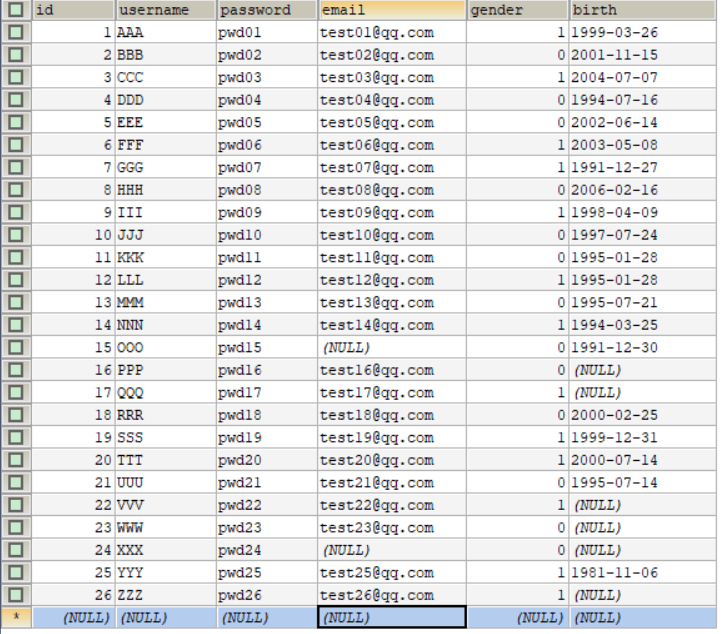
2. Test whether you can connect to the database
package com.example.pagingQuery;
import org.junit.jupiter.api.Test;
import org.springframework.beans.factory.annotation.Autowired;
import org.springframework.boot.test.context.SpringBootTest;
import javax.sql.DataSource;
import java.sql.Connection;
import java.sql.SQLException;
@SpringBootTest
class PagingQueryApplicationTests {
//DI injection data source
@Autowired
DataSource dataSource;
@Test
void contextLoads() throws SQLException {
//Take a look at the default data source
System.out.println(dataSource.getClass());
//Get connection
Connection connection = dataSource.getConnection();
System.out.println(connection);
//Close connection
connection.close();
}
}
Whether the test runs successfully. If it is successful, it indicates that the database is successfully connected.
5, Architecture preparation
1. User class
package com.example.pagingQuery.pojo;
import lombok.AllArgsConstructor;
import lombok.Data;
import lombok.NoArgsConstructor;
import java.util.Date;
@Data
@AllArgsConstructor
@NoArgsConstructor
public class User {
private Integer id;
private String username;
private String password;
private String email;
private Integer gender;//0: female 1: Male
private Date birth;
}
2,UserDao
package com.example.pagingQuery.dao;
import com.example.pagingQuery.pojo.User;
import org.springframework.beans.factory.annotation.Autowired;
import org.springframework.jdbc.core.JdbcTemplate;
import org.springframework.stereotype.Repository;
import org.springframework.web.bind.annotation.GetMapping;
import java.text.ParseException;
import java.text.SimpleDateFormat;
import java.util.ArrayList;
import java.util.Date;
import java.util.List;
import java.util.Map;
@Repository
public class UserDao {
@Autowired
JdbcTemplate jdbcTemplate;
//Get all user information
public List<User> getUserList() throws ParseException {
String sql = "select * from `user`";
List<Map<String, Object>> userList = jdbcTemplate.queryForList(sql);
ArrayList<User> users = new ArrayList<>();
for (int i = 0; i < userList.size(); i++) {
int id = ((Number) userList.get(i).get("id")).intValue();
String username = (String) userList.get(i).get("username");
String password = (String) userList.get(i).get("password");
String email = (String) userList.get(i).get("email");
int gender = ((Number) userList.get(i).get("gender")).intValue();
SimpleDateFormat dateFormat = new SimpleDateFormat("yyyy-MM-dd");
Date birth = dateFormat.parse((String) userList.get(i).get("birth"));
User user = new User(id, username, password, email, gender, birth);
users.add(user);
}
return users;
}
}
3. View controller MyMvcConfig
package com.example.pagingQuery.config;
import org.springframework.context.annotation.Configuration;
import org.springframework.web.servlet.config.annotation.EnableWebMvc;
import org.springframework.web.servlet.config.annotation.ViewControllerRegistry;
import org.springframework.web.servlet.config.annotation.WebMvcConfigurer;
@Configuration
public class MyMvcConfig implements WebMvcConfigurer {
//Add view controller
@Override
public void addViewControllers(ViewControllerRegistry registry) {
registry.addViewController("/").setViewName("userlist");
}
}
4. Static resources
Static resources use Bootstrap v3 to obtain static resource links (permanently valid):
Link: https://pan.baidu.com/s/1oq17a4uodSNYWwYNMfjIVw
Extraction code: MySQL
5,userlist.html static page
Note: the following is a static page
<!DOCTYPE html>
<html lang="en" xmlns:th="http://www.thymeleaf.org">
<head>
<meta charset="UTF-8">
<title>Title</title>
<!-- introduce Bootstrap v3 Static resources-->
<link rel="stylesheet" href="../static/bootstrap-3.4.1-dist/css/bootstrap.min.css" th:href="@{/bootstrap-3.4.1-dist/css/bootstrap.min.css}">
<link rel="stylesheet" href="../static/bootstrap-3.4.1-dist/css/bootstrap.min.css.map" th:href="@{/bootstrap-3.4.1-dist/css/bootstrap.min.css.map}">
<style>
.table-wrapper{
min-height: 300px;
}
.paging{
width: 100%;
height: 150px;
position: relative;
}
.paging nav{
display: block;
margin: auto;
position: absolute;
left: 600px;
top: 30px;
}
</style>
</head>
<body>
<div class="panel panel-default">
<!-- Default panel contents -->
<div class="panel-heading">Panel heading</div>
<div class="panel-body">
<p><Legend of Zhen Huan forever</p>
</div>
<!-- Table -->
<div class="table-wrapper">
<table class="table table-striped">
<thead>
<tr>
<th>Serial number</th>
<th>user name</th>
<th>password</th>
<th>mailbox</th>
<th>Gender</th>
<th>birthday</th>
</tr>
</thead>
<tbody>
<tr>
<td>1</td>
<td>AAA</td>
<td>123456</td>
<td>test01@qq.com</td>
<td>male</td>
<td>2001-07-03</td>
</tr>
<tr>
<td>2</td>
<td>BBB</td>
<td>123456</td>
<td>test02@qq.com</td>
<td>male</td>
<td>2001-07-03</td>
</tr>
<tr>
<td>3</td>
<td>CCC</td>
<td>123456</td>
<td>test03@qq.com</td>
<td>male</td>
<td>2001-07-03</td>
</tr>
<tr>
<td>4</td>
<td>DDD</td>
<td>123456</td>
<td>test04@qq.com</td>
<td>male</td>
<td>2001-07-03</td>
</tr>
<tr>
<td>5</td>
<td>EEE</td>
<td>123456</td>
<td>test05@qq.com</td>
<td>male</td>
<td>2001-07-03</td>
</tr>
<tr>
<td>6</td>
<td>FFF</td>
<td>123456</td>
<td>test06@qq.com</td>
<td>male</td>
<td>2001-07-03</td>
</tr>
<tr>
<td>7</td>
<td>GGG</td>
<td>123456</td>
<td>test07@qq.com</td>
<td>male</td>
<td>2001-07-03</td>
</tr>
</tbody>
</table>
</div>
<!-- paging -->
<div class="paging">
<nav aria-label="Page navigation">
<ul class="pagination pagination-lg">
<li>
<a href="#" aria-label="Previous">
<span aria-hidden="true">«</span>
</a>
</li>
<li><a href="#">1</a></li>
<li><a href="#">2</a></li>
<li><a href="#">3</a></li>
<li><a href="#">4</a></li>
<li><a href="#">5</a></li>
<li>
<a href="#" aria-label="Next">
<span aria-hidden="true">»</span>
</a>
</li>
</ul>
</nav>
</div>
</div>
</body>
</html>
The static page effect is shown in the following figure:
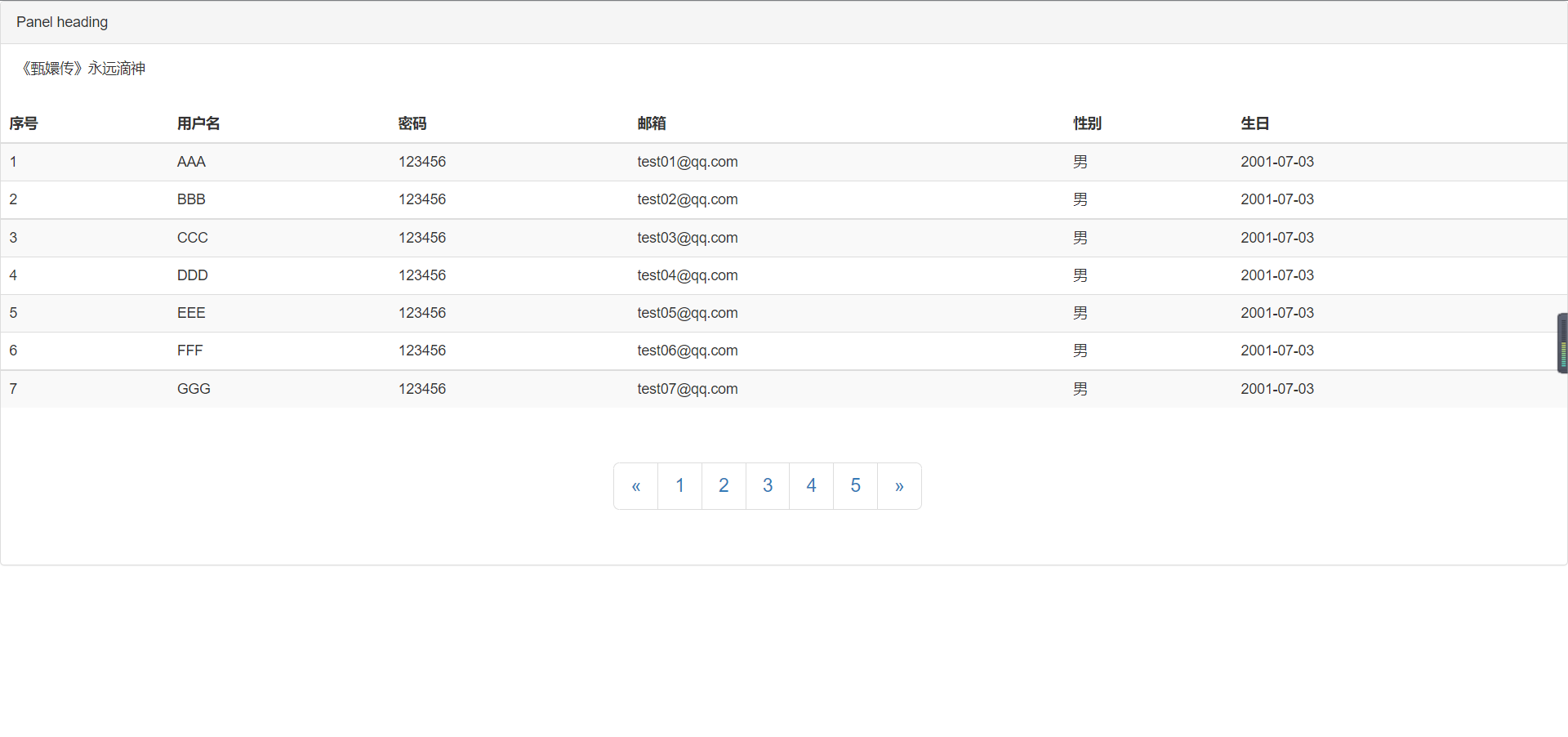
6. UserController class
package com.example.pagingQuery.controller;
import com.example.pagingQuery.dao.UserDao;
import com.example.pagingQuery.pojo.User;
import org.springframework.beans.factory.annotation.Autowired;
import org.springframework.stereotype.Controller;
import org.springframework.ui.Model;
import org.springframework.web.bind.annotation.GetMapping;
import java.text.ParseException;
import java.util.List;
@Controller
public class UserController {
@Autowired
UserDao userDao;
@GetMapping("/")
public String showList(Model model){
List<User> users = userDao.getUserList();
model.addAttribute("users",users);
return "userlist";
}
}
7,userlist.html dynamic page
<!DOCTYPE html>
<html lang="en" xmlns:th="http://www.thymeleaf.org">
<head>
<meta charset="UTF-8">
<title>Title</title>
<!-- introduce Bootstrap v3 Static resources-->
<link rel="stylesheet" href="../static/bootstrap-3.4.1-dist/css/bootstrap.min.css" th:href="@{/bootstrap-3.4.1-dist/css/bootstrap.min.css}">
<link rel="stylesheet" href="../static/bootstrap-3.4.1-dist/css/bootstrap.min.css.map" th:href="@{/bootstrap-3.4.1-dist/css/bootstrap.min.css.map}">
<style>
.table-wrapper{
min-height: 300px;
}
.paging{
width: 100%;
height: 150px;
position: relative;
}
.paging nav{
display: block;
margin: auto;
position: absolute;
left: 600px;
top: 30px;
}
</style>
</head>
<body>
<div class="panel panel-default">
<!-- Default panel contents -->
<div class="panel-heading">Panel heading</div>
<div class="panel-body">
<p><Legend of Zhen Huan forever</p>
</div>
<!-- Table -->
<div class="table-wrapper">
<table class="table table-striped">
<thead>
<tr>
<th>Serial number</th>
<th>user name</th>
<th>password</th>
<th>mailbox</th>
<th>Gender</th>
<th>birthday</th>
</tr>
</thead>
<tbody>
<tr th:each="user:${users}">
<td th:text="${user.getId()}"></td>
<td th:text="${user.getUsername()}"></td>
<td th:text="${user.getPassword()}"></td>
<td th:text="${user.getEmail()}"></td>
<td th:text="${user.getGender()==0?'female':'male'}"></td>
<td th:text="${#dates.format(user.getBirth(),'yyyy-MM-dd')}"></td>
</tr>
</tbody>
</table>
</div>
<!-- paging -->
<div class="paging">
<nav aria-label="Page navigation">
<ul class="pagination pagination-lg">
<li>
<a href="#" aria-label="Previous">
<span aria-hidden="true">«</span>
</a>
</li>
<li><a href="#">1</a></li>
<li><a href="#">2</a></li>
<li><a href="#">3</a></li>
<li><a href="#">4</a></li>
<li><a href="#">5</a></li>
<li>
<a href="#" aria-label="Next">
<span aria-hidden="true">»</span>
</a>
</li>
</ul>
</nav>
</div>
</div>
</body>
</html>
Run the program to get the dynamic page effect, as shown in the figure below:
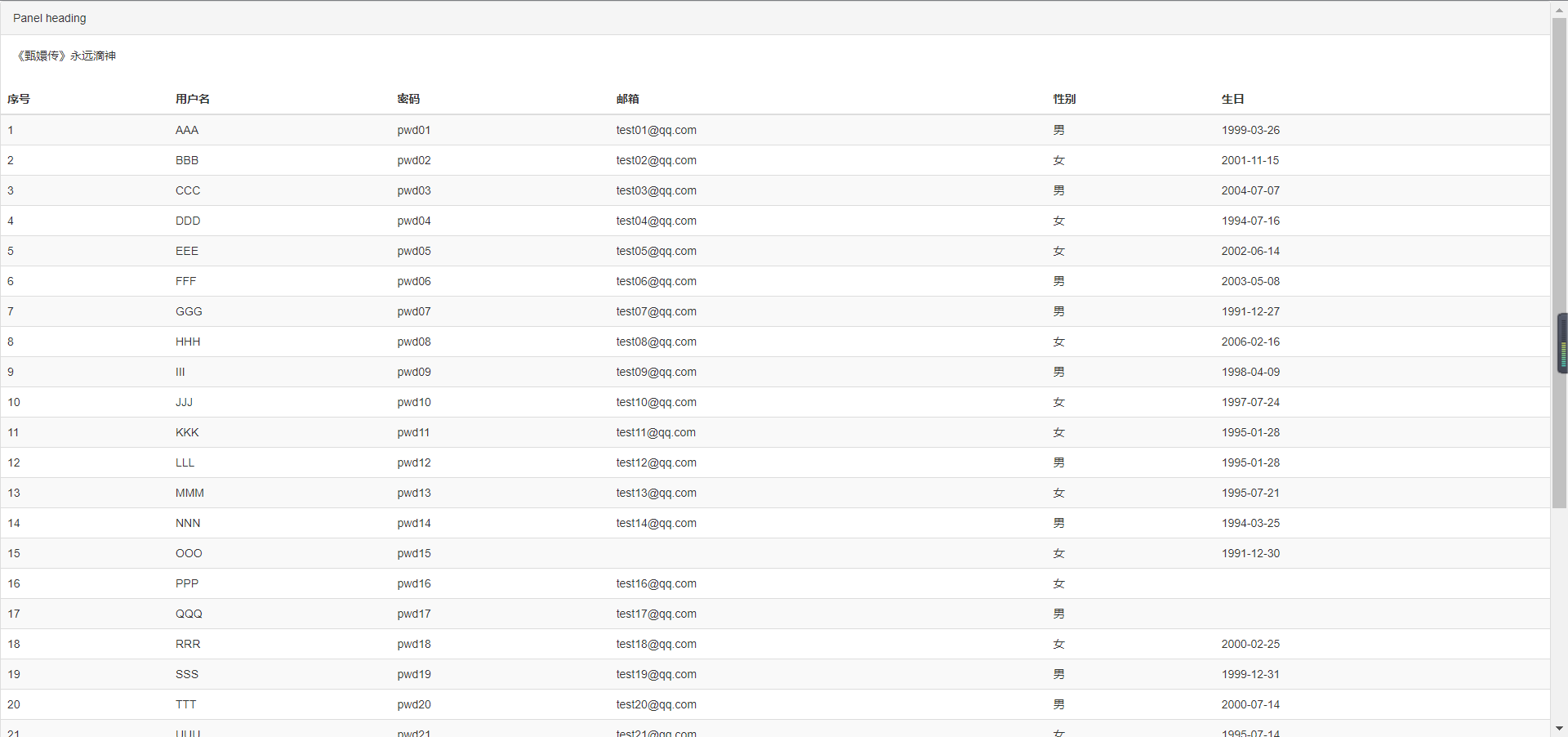
At this time, the preparation work is completed. Let's start paging
6, Research on the realization of paging function
1. Create PageList class
First, create a PageList class to represent each page
package com.example.pagingQuery.pojo;
import lombok.AllArgsConstructor;
import lombok.Data;
import lombok.NoArgsConstructor;
import java.util.ArrayList;
import java.util.List;
@Data
@AllArgsConstructor
@NoArgsConstructor
public class PageList<T> {
private int pageSize; //Maximum data volume per page
private int dataNumber; //Total data volume of Java class T
private int pageNumber; //Total pages total pages = (total data volume% maximum data volume per page) = = 0? (total data volume / maximum data volume per page): ((total data volume / maximum data volume per page) + 1)
private int currentPage; //Current page
private List<T> dataList = new ArrayList<T>(); //All data of the current page
public PageList(int currentPage,int pageSize,int dataNumber){
this.currentPage = currentPage;
this.pageSize = pageSize;
pageNumber = (dataNumber%pageSize==0?(dataNumber/pageSize):(dataNumber/pageSize+1));
}
}
- currentPage: the current page refers to the target page we want to display when the user clicks a page
- The main purpose of dataNumber and pageSize is to calculate the total number of pages
- dataList is used to store the data list we want to present to users
2. UserDao paging method
Add a paging method in UserDao to return the data list according to the single page data size transmitted from the front page and the current page
//The paging function is realized to obtain paging data
//This function is called when the front page clicks the pager
public PageList<User> getUserListByPage(int currentPage,int pageSize){
//Set the maximum amount of data for the current page and each page
//Here I set the maximum amount of data per page to 7
PageList<User> userPageList = new PageList<>(currentPage, pageSize);
//Get all user data. It is easy to know that the total amount of data is 26
userPageList.setDataNumber(jdbcTemplate.queryForObject("SELECT count(id) FROM `user`",Integer.class));
//Determine the display data list of the current page according to the situation of the current page
if (userPageList.getCurrentPage()==userPageList.getPageNumber()){
//The current page is the last page of the total page
userPageList.setDataList(jdbcTemplate.query("SELECT * FROM `user` limit ?,?",new BeanPropertyRowMapper<>(User.class),(currentPage-1)*pageSize,userPageList.getDataNumber()-(currentPage-1)*pageSize-1));
}else {
userPageList.setDataList(jdbcTemplate.query("SELECT * FROM `user` limit ?,?",new BeanPropertyRowMapper<>(User.class),(currentPage-1)*pageSize,pageSize));
}
return userPageList;
}
3,userlist.html page modification
It is mainly to modify the pager and use JS for page processing
<!DOCTYPE html>
<html lang="en" xmlns:th="http://www.thymeleaf.org">
<head>
<meta charset="UTF-8">
<title>Title</title>
<!-- introduce Bootstrap v3 Static resources-->
<link rel="stylesheet" href="../static/bootstrap-3.4.1-dist/css/bootstrap.min.css" th:href="@{/bootstrap-3.4.1-dist/css/bootstrap.min.css}">
<link rel="stylesheet" href="../static/bootstrap-3.4.1-dist/css/bootstrap.min.css.map" th:href="@{/bootstrap-3.4.1-dist/css/bootstrap.min.css.map}">
<style>
.table-wrapper{
min-height: 300px;
}
.paging{
width: 100%;
height: 150px;
position: relative;
}
.paging nav{
display: block;
margin: auto;
position: absolute;
left: 600px;
top: 30px;
}
</style>
</head>
<body>
<div class="panel panel-default">
<!-- Default panel contents -->
<div class="panel-heading">Panel heading</div>
<div class="panel-body">
<p><Legend of Zhen Huan forever</p>
</div>
<!-- Table -->
<div class="table-wrapper">
<table class="table table-striped">
<thead>
<tr>
<th>Serial number</th>
<th>user name</th>
<th>password</th>
<th>mailbox</th>
<th>Gender</th>
<th>birthday</th>
</tr>
</thead>
<tbody>
<tr th:each="userByPage:${usersByPage}">
<td th:text="${userByPage.getId()}"></td>
<td th:text="${userByPage.getUsername()}"></td>
<td th:text="${userByPage.getPassword()}"></td>
<td th:text="${userByPage.getEmail()}"></td>
<td th:text="${userByPage.getGender()==0?'female':'male'}"></td>
<td th:text="${#dates.format(userByPage.getBirth(),'yyyy-MM-dd')}"></td>
</tr>
</tbody>
</table>
</div>
<!-- paging -->
<div class="paging">
<!-- Customize a container for storing pageNumber Data and let this container display:none;-->
<div id="pageNumber" th:text="${pageNumber}" style="display: none"></div>
<nav aria-label="Page navigation">
<ul id="sorter" class="pagination pagination-lg">
</ul>
</nav>
</div>
</div>
<script>
window.onload = function (){
//Get pageNumber
let pageNumber = document.getElementById("pageNumber");
let number = parseInt(pageNumber.innerText);
//Get ul object
let sorter = document.getElementById("sorter");
sorter.innerHTML += '<li><a href="#" aria-label="Previous"><span aria-hidden="true">«</span></a></li>';
for (let i = 0; i < number; i++) {
sorter.innerHTML += '<li><a href="' + (i+1)+ '">' + (i+1) + '</a></li>';
}
sorter.innerHTML += '<li><a href="#" aria-label="Previous"><span aria-hidden="true">»</span></a></li>';
}
</script>
</body>
</html>
4. UserController modification
package com.example.pagingQuery.controller;
import com.example.pagingQuery.dao.UserDao;
import com.example.pagingQuery.pojo.PageList;
import com.example.pagingQuery.pojo.User;
import org.springframework.beans.factory.annotation.Autowired;
import org.springframework.stereotype.Controller;
import org.springframework.ui.Model;
import org.springframework.web.bind.annotation.GetMapping;
import org.springframework.web.bind.annotation.PathVariable;
import java.text.ParseException;
import java.util.List;
@Controller
public class UserController {
@Autowired
UserDao userDao;
@GetMapping("/")
public String showList(Model model){
List<User> users = userDao.getUserList();
model.addAttribute("users",users);
return "userlist";
}
@GetMapping("/user/{pageSize}/{currentPage}")
public PageList<User> UserPageList(@PathVariable("pageSize") int pageSize,@PathVariable("currentPage") int currentPage){
return userDao.getUserListByPage(currentPage,pageSize);
}
@GetMapping({"/user/listByPage/{currentPage}","localhost:8080/user/listByPage/{currentPage}"})
public String showListByPage(@PathVariable("currentPage") int currentPage,Model model){
PageList<User> userPageList = UserPageList(7, currentPage);
//Give it a different name and distinguish it from showList
List<User> usersByPage = userPageList.getDataList();
model.addAttribute("usersByPage",usersByPage);
//Get total pages
int pageNumber = userPageList.getPageNumber();
model.addAttribute("pageNumber",pageNumber);
return "userlist";
}
}
5. Display renderings
Effect picture 1
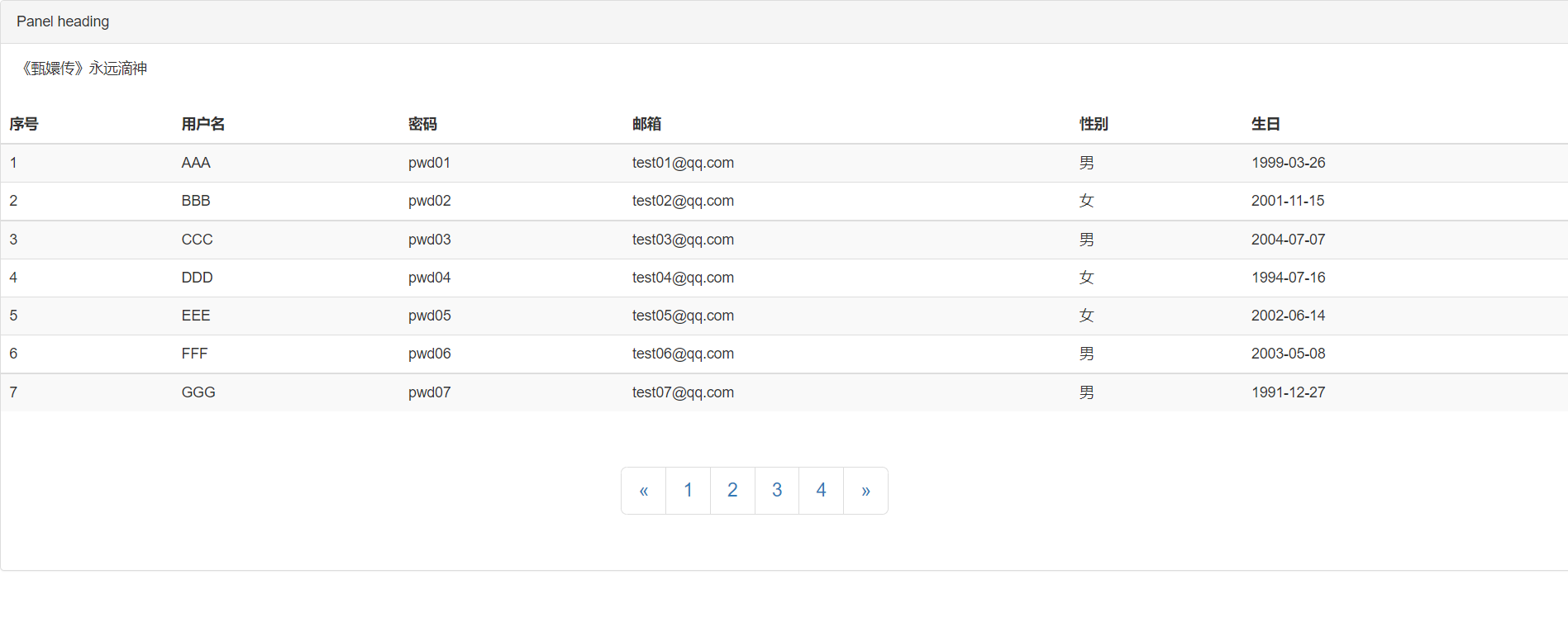
Effect drawing 2
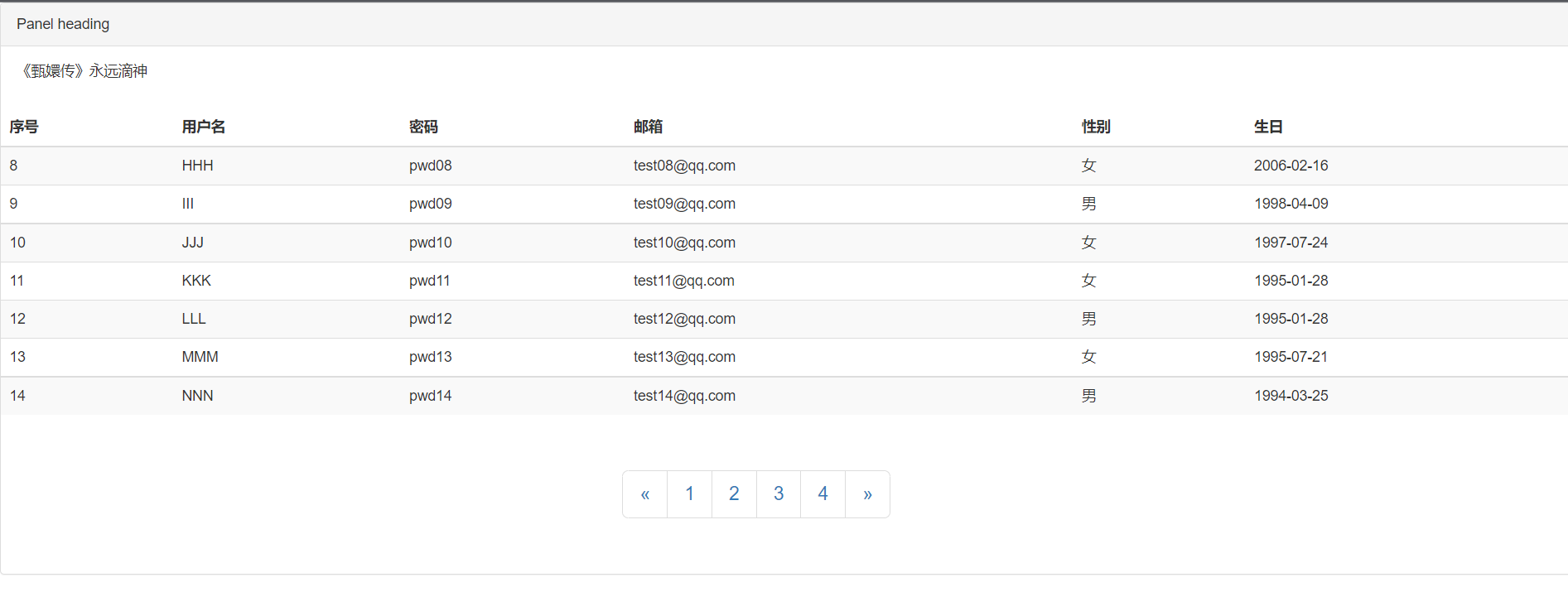
Effect figure 3
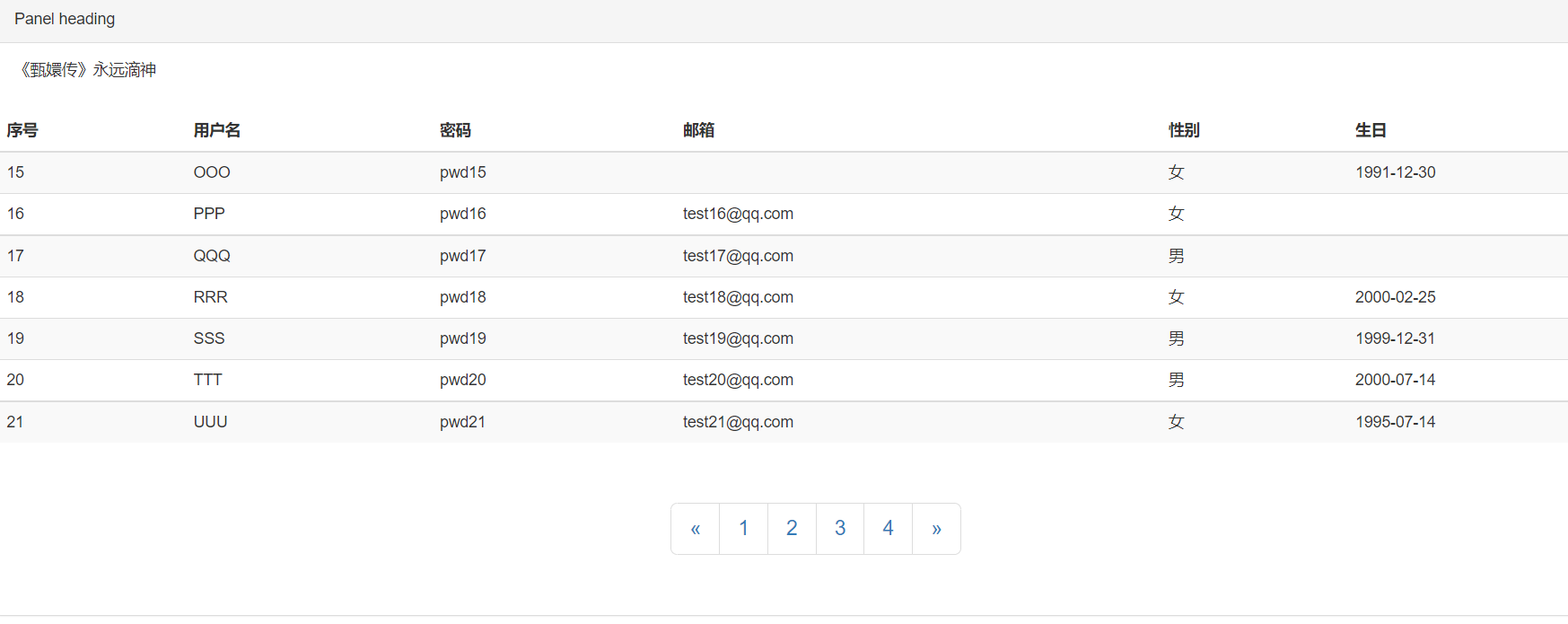
Effect figure 4
